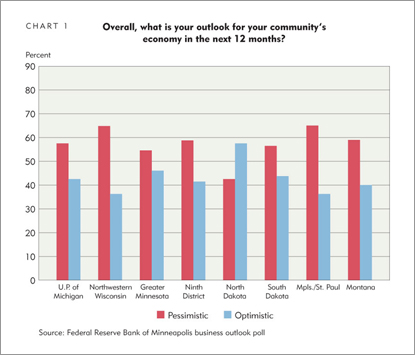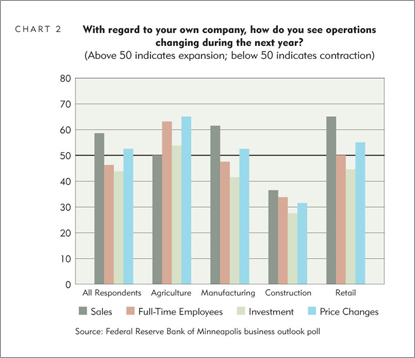Business leaders predict very sluggish growth in the U.S. economy in 2010, according to the November fedgazette business outlook poll. This was evident across district states as well as across economic sectors. Leaders remain pessimistic for their own businesses and communities. Tight credit conditions are still a concern for about a third of the respondents. The overall economic outlook is somewhat better than a year ago, and modest inflation is expected.
Respondents across the Ninth District believed their local economies would contract in 2010. Sentiment regarding business investment, employment, consumer spending and housing starts all remains pessimistic. Respondents see a rebound in sales revenues and anticipate flat prices for their products. However, they anticipate slight cuts in employees and capital investment. Leaders are not very concerned about finding good people, but are very concerned with government regulation.
Sluggish national growth
“There is going to be very slow growth,” commented a Minnesota manufacturer. About two-thirds of the respondents expect growth in U.S. GDP of 1 percent to 2 percent, and one quarter expect a recession in 2010. Responses were consistent across the district, with a slightly higher proportion of U.P. respondents expecting the recession to continue. Meanwhile, more respondents from the agriculture and construction industries expect a continued recession compared with those from the manufacturing industry. “Our general contracting business has no backlog and our real estate company has no clients,” said a U.P. construction company respondent.
Respondents believed inflation would be modest in 2010. Concerns about near-term inflation are generally muted: Nearly a quarter of respondents predicted inflation of only around 1 percent, and 42 percent about 2 percent; however, 19 percent predicted inflation of 4 percent or higher, the highest percentage of which come from Montana and northwestern Wisconsin. Several leaders indicated that they are very concerned about higher inflation hitting in a few years. “Expect CPI to have a slow change over the next 12 months, but faster than average in inflation in 24 to 36 months,” a Montana respondent said.
Pessimism
Almost 60 percent of respondents are pessimistic about their community’s economic performance in 2010 (see Chart 1). The pessimism is strongest in the Minneapolis/St. Paul area and northwetern Wisconsin. In contrast, North Dakota respondents were optimistic.
Respondents across the district and economic sectors expect large declines in employment in their community’s economy. Anticipated wage increases are very soft, as nearly two-thirds expect 0 percent to 1 percent increases in 2010. No respondents expect wages in their community to rise more than 3 percent. Meanwhile, business investment is expected to fall in 2010. “There is little incentive to invest in any new business expansion with prospects for higher taxes, more regulation and depressed demand for services,” a Minnesota respondent said.
The decrease in employment and capital investment may be affected by the consumer spending outlook. Nearly half of the respondents believe consumers will spend less in their communities. The results are similar for respondents across states and sectors.
Nearly half of respondents also predict that housing starts will decline further in 2010. “There is no sign of recovery in housing,” commented a Minnesota manufacturer that supports the housing industry. Respondents from all district states and economic sectors expect an overall decline in housing starts in 2010.
Higher sales but less employment and investment
Sales revenue in 2010 is expected to increase from 2009 levels across the district except in Montana, where a sales decrease is anticipated (see Chart 2). Meanwhile, sales gains are expected across all sectors except construction. “Forest products have been terrible for three and a half years with another year, at least, to go,” commented a Montana manufacturer that supports the construction industry.
Meanwhile, employment is projected to fall further. A quarter of the respondents expect to decrease employment in 2010, while 18 percent expect to increase jobs. Every sector and geographic area foresees decreased hiring. Most respondents reported that securing workers is not a challenge.
Access to credit may be affecting hiring and capital expenditure decisions. About a third of the respondents reported that access to bank credit has deteriorated over the past three months. As a result, 21 percent of respondents said it affected their hiring plans. “Businesses are struggling and, as they weaken, credit just gets tougher,” commented a Minnesota manufacturer. Another Minnesota manufacturer noted that “banks are pulling back on credit—they need to continue lending or small businesses like us will struggle and fail.” Tighter credit may be affecting capital expenditures, as nearly a third said the difficulty accessing credit has hurt planned capital expenditures. “They have added new restrictive reporting requirements and are not funding projects they would have funded in the past,” said a Minnesota agricultural producer.
Investment in plant and equipment is expected to drop in 2010, with a third of respondents expecting decreased levels and 21 percent anticipating increased levels. The decrease is widespread across sectors and geography. Productivity was sluggish in 2009: 44 percent of respondents reported level or decreased productivity.
Company pricing pressure is modest. A quarter of respondents expect to increase prices on their products and services, while 20 percent see price declines in 2010. Moderate price pressure is stable across district states but varies among sectors. Only 5 percent of construction firms expect to increase prices, while 40 percent expect to decrease prices. Meanwhile, 57 percent of agricultural producers expect higher prices for their products.
The biggest challenge facing businesses is complying with government regulation. Eighty-six percent of respondents reported that complying with government regulations will be a challenge in 2010. Said one Minnesota construction company, “Government regulation continues to add cost with little benefit realized.”
Business Poll Results [xls]







